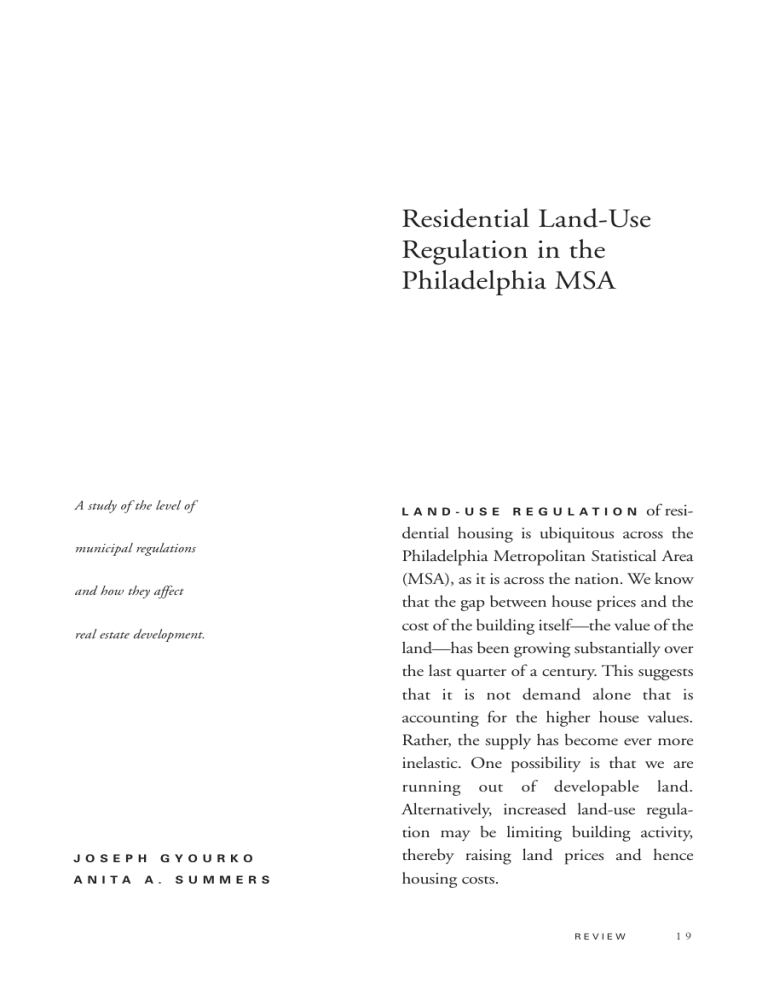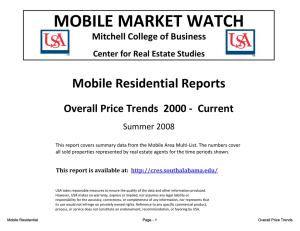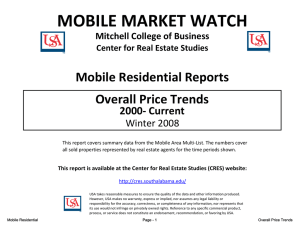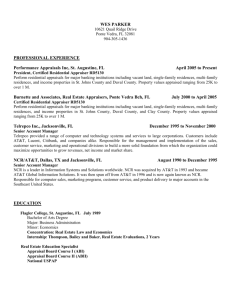Residential Land-Use Regulation in the Philadelphia MSA
advertisement

Residential Land-Use Regulation in the Philadelphia MSA A study of the level of municipal regulations and how they affect real estate development. JOSEPH ANITA GYOURKO A. SUMMERS R E G U L A T I O N of residential housing is ubiquitous across the Philadelphia Metropolitan Statistical Area (MSA), as it is across the nation. We know that the gap between house prices and the cost of the building itself—the value of the land—has been growing substantially over the last quarter of a century. This suggests that it is not demand alone that is accounting for the higher house values. Rather, the supply has become ever more inelastic. One possibility is that we are running out of developable land. Alternatively, increased land-use regulation may be limiting building activity, thereby raising land prices and hence housing costs. LAND-USE REVIEW 19 Local pressure groups argue for more open space, more impact fees, and lower density. Are these political pressures effective in increasing the controls over residential land use? If so, they may also be increasing housing costs and reducing the availability of affordable housing. At the same time, there are pressures from developers and the construction industry to reduce regulations. State governments and state courts also play a role in the degree of control local communities can exercise over land-use controls. These controls have an effect on the broader region, not just on the local community. There is a scarcity of rigorously based knowledge of the origins and effects of local land use regulation, primarily because land-use regulations are under local control and the data describing them is largely non-existent. To address this deficit, the Zell/Lurie Real Estate Center at the Wharton School of the University of Pennsylvania carried out a national and regional survey of residential land-use regulations. A detailed examination of regulations in the Philadelphia MSA is the subject of this paper. The primary aim of our survey was to document and analyze differences in the local land use regulatory environment across communities. To do so, we created a new metric of the local land use regulation environment that allows us to rank individual communities by 20 ZELL/LURIE REAL ESTATE CENTER their degree of regulatory control. We contrast conditions across communities within the Philadelphia metropolitan area, comparing this region with the rest of the country. In addition, we make a preliminary examination of the relationships between regulatory differences, single-family lot cost increases, and local socioeconomic indicators. THE SURVEY In 2005, we mailed a survey to 351 local jurisdictions in the nine counties that comprise the Philadelphia MSA. We received responses from 227 localities, representing more than 64 percent of the municipalities and 89 percent of the total population, although nine communities provided insufficient information for us to compute an overall regulation index for them. Response rates were very high from places with at least 7,500 residents; more than 80 percent of the non-responders were communities with a population of 7,500 or fewer. The survey asked fifteen multi-faceted questions, focusing on identifying the general characteristics of the land regulatory process, the important residential land use regulations prevailing in the area, and on identifying key outcomes of the local regulatory environment. Four questions explored the intensity of involvement in the regulatory process by different entities. Three features stand out in the answers to these questions: local actors are perceived to be substantially more involved than state actors, local courts, or county legislatures; community pressure groups are perceived to be important players— two to three times as important as the others, but less than 40 percent of the importance of the local entities; and 75 percent of the respondents regarded the local and state courts to have relatively low influence. Some type of board or council approves zoning changes in virtually all communities—less than 1 percent do not have such a body, and more than 60 percent require two or more such approvals. Even when approval does not require rezoning, multiple approvals are almost always required—only 4 percent of the communities do not require approval by at least one entity, and more than 60 percent require two or more approvals. The dominance of multiple approval points for zoning changes and for new projects that require no zoning changes is consistent with a process calculated to slow down development and growth. Several conclusions emerge from our public sector respondents: the supply of land is overwhelmingly regarded as the most important factor driving the rate of residential development—81 percent of the respondents listed this factor for singlefamily residential development, and 77 percent for multifamily; more than 60 percent of the respondents said density restrictions had high impact; less than a quarter of the respondents felt the process of carrying out the regulatory process—review times—was very important. However, 43 percent of the respondents said the costs of the new infrastructure associated with development were very important. Another question asked if communities had annual permit limits for singleand multifamily building permits, residential units authorized for construction, and the number of units in multifamily dwellings. The answer is a resounding “No.” Only 13 communities claimed to have such limits, with less than 4 percent indicating there were limits on singlefamily permits. To the extent that a community seeks to limit residential building to less than what would be generated by market forces, they are not doing so through annual permit limits. We also asked about other restrictions and requirements. The survey responses indicate that minimum lot size requirements are ubiquitous. Ninety-one percent of communities control density with some type of minimum lot size requirement. Among this group, 71 percent report that they have some minimum lot size requirements below one-half acre, but 47 percent have some lot size minimums of more than half an acre. Of this latter set, 55 percent report some lot size minimums of REVIEW 21 more than one acre, with 48 percent indicating that they have some part of their community with a minimum of two acres or more. Thus, many jurisdictions in the Philadelphia metropolitan area maintain very low densities, in at least some parts of their communities, through minimum lot size restrictions. The survey asked whether builders were subject to affordable housing requirements or fees in lieu of dedication, and whether they had to pay allocable shares of costs associated with the infrastructure improvements. A third of the communities reported that they had affordable housing requirements. However, this masks the wide disparity between Pennsylvania and New Jersey localities (the latter are required to provide affordable housing by state law). Open space and infrastructure cost requirements are more prevalent within the metropolitan area, with two-thirds of the sample reporting that developers were subject to such regulation in their communities. A series of questions focused on the characteristics and perceived outcomes of the residential land-use regulatory controls. Regarding the supply-demand balance of the acreage of land zoned for single-family, multifamily, commercial and industrial use, more than half of the communities described either an excess supply of land or a supply-demand balance. For single-family and multifamily 22 ZELL/LURIE REAL ESTATE CENTER land use, however, roughly 50 percent described a land shortage—44 percent and 47 percent, respectively. For commercial and industrial land-use, a third of the places reported a land shortage. Thus, there is substantial heterogeneity in the perception by respondents about the nature of land shortage in their communities. We asked how much the cost of lot development (including subdivisions) had increased over the last ten years. Almost 30 percent of the communities reported real cost declines over the ten years preceding the survey. About 25 percent experienced lot development cost increases in line with general inflation, while 57 percent had lot development cost increases in real terms. More than 11 percent of the sample reported at least a doubling of real costs over the past decade. In terms of cost increases for a single-family lot, the cost escalation was higher. More than 70 percent of the communities reported real lot cost increases, with more than 22 percent of the sample seeing real costs doubling (or more). We asked how long it took to review projects and obtain permits, specifically querying the length of time to complete the review of residential projects. For singlefamily residences, the average review time was almost six months; for multi-family homes, more than seven months. About two-thirds of the communities experienced single-family review times that were within plus or minus five months of the average for single-family homes, and plus or minus six-and-a-half months of the average for multi-family homes. A followup question asked how the length of time to complete the review and approval of residential projects in the community had changed over the previous decade. More than 60 percent of the respondents indicated that there was no change; 25 percent to 30 percent indicated it was somewhat longer; less than 10 percent indicated it was appreciably longer. There are delays in the approval process. Even for small developments (involving fewer than fifty single-family units), only about one in six applications are processed in under ninety days, and over 60 percent take more than half a year; almost one third take more than a year. For larger developments of single-family units, the comparable numbers are one in ten, more than 70 percent, and roughly 50 percent. For multifamily developments, more than 65 percent take more than a year, and more than 6 percent take more than two years. In cases where appropriate zoning is already in place, lags of more than a year exist for 18 percent of the communities for the smaller single-family developments, for 34 percent of the larger developments, and for 32 percent of the multifamily applications. The final two questions of the survey related to zoning changes. The Philadelphia MSA annual average is six applications for changes, but the variation is very large across the region. On average, four-and-a-half zoning-change applications are approved, yielding an average approval ratio of 75 percent. This means that what gets submitted tends to get approved. That is, developers tend to submit only what they believe is going to be approved. POLITICAL PRESSURES One of the enduring debates is between community groups focused on preserving open space and a variety of environmental characteristics, and the homebuilding industry focused on lessening the time and costs associated with local land use regulation. We were able to explore whether political activity by the real estate industry is effective in lightening regulatory burdens, and whether political activity regarding land use conservation ballot initiatives and the amount of local regulation add to the level of control. Using data on political campaign contributions, we computed the total number and the aggregate amount of campaign contributions made to candidates for the state legislature between 1989 and 2005 by employees in the construction and real estate industries. After creating per capita versions of these variables (to eliminate the REVIEW 23 effect of the different scales of districts), the figures were matched to jurisdictions based on the location of the legislator’s district. A graphical overlay of the local communities from which the contributions came with the legislative districts was used, with the contributions allocated according to the population of the community in the district. If the objective of these contributions was to encourage a more laissez-faire approach to land-use regulation—lower levels of land-use control—we would expect to find a negative correlation between the two political contribution variables and the degree of local land use regulation. That is precisely what we find: the correlation coefficient between the number of real estate and construction industry contributions per capita is -0.34, while that for the per capita amount is -0.32. These figures suggest that the efforts by the housing industry to reduce regulations are at least somewhat effective. Environmentalists and various community groups also try to influence the local regulatory climate. Data on local conservation funding were assembled to examine their effectiveness in controlling development. There was a significantly positive correlation between the strength of public pressures for land preservation and the strength of land-use regulations. Using information from the Trust for Public Land’s Landvote website, three 24 ZELL/LURIE REAL ESTATE CENTER measures of community pressure were examined, each based on data between 1996 and 2005 and calibrated per capita. The first is the total number of ballot initiatives for land conservation in each jurisdiction; the second is the total amount of conservation funds proposed on the ballots; and the third is derived from the total amount of conservation funds actually approved by voters. All three measures are significantly and positively correlated with a subindex of the local regulations. The correlations coefficients are +0.24, +0.24, and +0.15, respectively. The first two are significant at the 1 percent level and the third is significant at the 2 percent level. These results suggest that both the builder and environmental constituencies are able to influence the degree of local land use regulation. Each group appears to use the political process effectively, although their precise avenues of influence are quite different. THE WHARTON LAND USE RESIDENTIAL REGULATION INDEX We constructed an aggregate index of the degree of control over residential land-use in each jurisdiction using data from our survey and selected other information on state-level land use activities. The Wharton Residential Land Use Regulation Index (WRLURI) was created using factor analysis on a set of eleven subindexes, each of which was derived from responses to our survey, and from information on state-level activities regarding land use control. This aggregate measure perhaps best captures the local community’s landuse regulation environment. The bulk of the data is from our survey, supplemented by several other special data compilations. We capture measurements of local political pressures, state executive and legislative activity, state and local court rulings, zoning requirements, zoning change requirements, importance of the length of the regulatory process, density restrictions, restrictions on new construction, requirements for minimum lot size, affordable housing, open space, pro-rated improvement costs, and actual delay times in the regulatory process. The aim of this index is to capture, in a single measure, the nature of the local regulatory environment. The index is constructed so that the community with the average regulatory climate in the nation has a value of zero. Thus, communities with WRLURI values below zero are less regulated than the national average, while those with WRLURI values above zero are more regulated than the average. This index is standardized with a national mean of zero and a standard deviation of one. This implies that a community with a WRLURI of +1 is one standard deviation above the national mean. Not only does this index allow us to rank each community in terms of its degree of control over local land use; it also can be compared to the national average (and other metropolitan areas that are part of our separate national sample). While this measure is relative in the sense that it tells us how much above or below the national average any community is, it also enables us to describe the regulatory environment that is “average” and compare it to communities that are more or less regulated than the mean. For some parts of our analyses, it was useful to examine the effects of specific survey answers alone. This is a subset of the full WRLURI. It excludes the data on political campaign contributions, voting, and state-level executive, legislative, and court activity that were obtained from external sources. A third index focuses on local political pressures. Several questions in the survey pertain to the perceived degree of intervention by different actors in the development process. The less important the intervention by the local political constituencies, institutions, and dynamics, the more “laissez-faire” the regulatory climate was deemed to be. The data from the survey were combined with data that capture the preferences of the local residents for land conservation versus development, as revealed by the funding they vote to allocate for that purpose. REVIEW 25 Figure 1: WRLURI for Philadelphia MSA WRLURI <0 0 - 0.5 0.5 - 1 1-2 >2 SUMMARY OF FINDINGS The Wharton Residential Land Use Regulation Index enabled us to document differences across communities within the region and to compare the Philadelphia metropolitan area to the rest of the country. In addition, the index provides a preliminary examination of the relationships between these variations in the regulatory climate and lot cost increases, socioeco- 26 ZELL/LURIE REAL ESTATE CENTER nomic indicators, pressure group influences, and state legislative and judicial actions. On average, the communities in this metropolitan area have much more regulated land use control climates than the typical American community has. Review times for residential projects are almost double those of the average for the rest of the country. By our index, the region is a full standard deviation above the U.S. Table I: Average WRLURI values—Metropolitan areas with more than 10 observations Metropolitan Area 1. 2. 3. 4. 5. 6. 7. 8. 9. 10. 11. 12. 13. 14. 15. 16. 17. 18. 19. 20. 21. 22. 23. 24. 25. 26. 27. 28. 29. 30. 31. 32. 33. 34. 35. 36. 37. 38. 39. 40. 41. 42. 43. 44. 45. 46. 47. Providence-Fall River-Warwick, R.I.-Mass. Boston, Mass.-N.H. Monmouth-Ocean, N.J. Philadelphia, Pa. San Francisco, Calif. Seattle-Bellevue-Everett, Wash. Denver, Colo. Bergen-Passaic, N.J. Phoenix-Mesa, Ariz. Fort Lauderdale, Fla. New York, N.Y. Riverside-San Bernardino, Calif. Newark, N.J. Harrisburg-Lebanon-Carlisle, Pa. Los Angeles-Long Beach, Calif. Springfield, Mass. Oakland, Calif. San Diego, Calif. Hartford, Conn. Orange County, Calif. Washington, D.C.-Md.-Va.-W.V. Minneapolis-St. Paul, Minn.-Wisc. Portland-Vancouver, Ore.-Wash. Milwaukee-Waukesha, Wisc. Detroit, Mich. Allentown-Bethlehem-Easton, Pa. Chicago, Ill. Akron, Ohio Pittsburgh, Pa. Nassau-Suffolk, N.Y. Atlanta, Ga. Scranton-Wilkes-Barre-Hazelton, Pa. Salt Lake City-Ogden, Utah Grand Rapids-Muskegon-Holland, Mich. Tampa-St. Petersburg-Clearwater, Fla. Cleveland-Lorain-Elyria, Ohio San Antonio, Texas Port Worth-Arlington, Texas Houston, Texas Rochester, N.Y. Dallas, Texas Oklahoma City, Okla. Dayton-Springfield, Ohio Cincinnati, Ohio-Ky.-Ind. St. Louis, Mo.-Ill. Indianapolis, Ind. Kansas City, Mo.-Kansas WRLURI 1.76 1.50 1.17 1.07 1.01 0.96 0.85 0.74 0.73 0.71 0.68 0.62 0.58 0.54 0.54 0.54 0.52 0.50 0.47 0.41 0.38 0.35 0.30 0.29 0.11 0.10 0.08 0.08 0.05 0.05 0.05 0.04 -0.09 -0.12 -0.17 -0.18 -0.23 -0.24 -0.26 -0.30 -0.33 -0.40 -0.50 -0.56 -0.71 -0.75 -0.79 Number of Observations 16 41 15 218 13 21 13 21 18 16 19 20 25 15 32 13 12 11 28 14 12 48 20 21 46 14 95 11 44 13 26 11 19 16 12 31 12 15 13 13 31 12 17 27 27 12 29 1. This table is taken from Table 11 of Gyourko, Saiz & Summers. 2 Metropolitan area definitions are based on 1999 boundaries. Consolidated Metropolitan Statistical Areas (CMSAs) are disaggregated into Primary Metropolitan Statistical Areas wherever relevant. REVIEW 27 mean in terms of regulation. Only the Boston and Providence metropolitan areas have significantly greater regulation (Table I). The degree of regulation in the Philadelphia metropolitan area is similar to that in the San Francisco and Seattle metropolitan areas. There is substantial variation in the regulatory environments across communities (Figure 1). At the county level, there are striking variations: the City of Philadelphia (also a county) is one of the least regulated places in the region, consistent with the results of our companion national study, which found consistently more regulation in the suburbs than in central cities; Delaware County (Pa.) and Camden County (N.J.) have the least regulation on average; Chester County (Pa.) is the most regulated county in the region, with a regulatory index more than one standard deviation above Delaware County’s, and with a typical community nearly 1.6 standard deviations above the typical community in the United States. At the community level, there are distinctive variations in the use of particular controls: statutory limits on permits and construction activities are rare; minimum lot size requirements are used in almost all communities; affordable housing requirements are used by only a third; open space and infrastructure cost payments are used by a substantial majority. 28 ZELL/LURIE REAL ESTATE CENTER At the state level, the average level of local regulation is similar in the Pennsylvania and New Jersey communities in the Philadelphia MSA. There were some notable differences, however: community pressure groups were much more influential on the Pennsylvania side; housing affordability requirements were much more widespread in New Jersey; average review times were a bit higher in the Pennsylvania communities. Some of these differences may derive from differences in socioeconomic characteristics, and some from differences in the involvement of the state in local land use control. There is a strong, positive correlation between the degree of regulation in a community and recent increases in land development costs, indicating that regulation is raising costs. Ultimately, this is reflected in housing prices. A striking finding is that the densest places have experienced the smallest lot cost increases over the past decade. This strongly suggests that fundamental land scarcity is not the driving force. The degree of control over land use is positively correlated with a number of measures of community wealth. These include financial wealth, as measured by average family income or house value, and human capital, as measured by educational attainment. The proportion of the population that is white is also positively correlated with regulatory control. Given the documented racial differences in income and wealth, this may be a proxy for community wealth. But this correlation may also reflect a direct racial motivation for stricter and use controls. Only future research can sort out those links. The population of a community is not correlated with the degree of regulation, but the physical size of the community is, with larger places being more highly regulated. Hence, population density is negatively correlated with the Wharton Residential Land Use Regulation Index. It cannot be, therefore, that the least dense places are most in danger of “running out of land.” There may well be an economic scarcity of land in them, but it is driven by the local regulatory policy, not a physical lack of land. The analysis of the simple correlations between community pressures for land conservation and local land use regulatory control indicate that politically oriented conservation pressures pay off in terms of more local restrictions. Similarly, the negative correlations between industry pressures, in the form of contributions to state legislators to encourage a more laissez-faire approach to land use regulation, and the regulatory control index suggests a payoff in terms of fewer local land use controls. In our companion analysis of land use regulation across the fifty states, we found that the activity of the executive and legislative branches of state government and the judicial environment in the state (assessed on the basis of appellate courts upholding or restraining local land use regulations) are relevant to understanding the wide variation of control across the country. The two states represented in the Philadelphia MSA have both been aggressive at both legislative and executive levels in exercising control over land use, but New Jersey has been more so. Similarly, state courts in both states have been encouraging of more state power over local land use regulation, but the New Jersey courts have been much less deferential to municipal control. CONCLUSIONS These findings do not answer the question of whether more regulation is better. This is an issue of whether the social benefits are greater than the costs. This paper has focused on measuring and documenting conditions across communities, which are the foundation of more complex costbenefit analysis. While we are not able to answer the question definitively here, our data and analysis have provided some useful insights into the issue. First, the strong positive correlation between the degree of regulation in a community and recent increases in land development costs indicated that regulation raises costs, reflected in higher REVIEW 29 housing prices. While higher housing prices clearly benefit owners, they can have serious social costs. By adversely influencing affordability, these costs can affect both what people can afford to buy and where they are able to live. Second, there are public and private gains to land use regulation. For example, lower density and open space are valuable environmental goods that many value; the creation and preservation of such attributes underpins at least some of the demand for more land use regulation. Another likely motivation for stricter regulation is the protection of capital gains on housing by current owners. Reduced supply can raise the probability of future price gains and reduce the probability of future price drops. However, this conveys no social gain, since the current owner’s gain is offset by the next owner’s loss from paying a higher price. Third, the cost-benefit issue is made even more complex when one tries to think about other costs such as those associated with commuting and pollution. If heavy regulation in one place leads to leapfrog development, commuting and pollution-related costs can rise. However, smart growth advocates have argued that regulation can be designed to deal with these issues, while increasing environmental amenities that benefit the entire community. 30 ZELL/LURIE REAL ESTATE CENTER The number of costs and benefits that have a public good dimension make it clear that the state is highly likely to have an important role in regulating local regulation. This is so because neither private interests nor individual communities should be expected to fully take account of what is in the interests of the broader region when making decisions about local land use regulation. For example, our analysis shows that both the real estate industry and environmental groups appear to be able to affect the land use environment through political contributions and local ballot initiative efforts. When both groups are successful, it seems reasonable to conclude that they are acting in their own best interests, which usually means ignoring potential costs to others— whether in terms of affordability problems altering home purchase decisions, or in terms of degraded environmental amenities. Similarly, when a locality decides to increase local regulation, it does so to help its existing residents, even if the action might impose costs on other communities or on the broader region by adding to commuting costs and more car-generated pollution. It is a higher level of government— the state in this case, since effective regional governments generally do not exist—that needs to take on the role of ensuring that social costs and benefits, not just private ones, are taken into account. In some cases, the proper role might be for state governments to provide incentives to localities to allow more new construction that is seen to be in the region’s interest. In others, it may be to do the opposite, if private interest on the construction side is acting in a way that reduces environmental amenities that have value to those outside the given locale. Ultimately, politics deals with issues such as this. Voters have choices to consider. There are tradeoffs to be made between public and private interests— between protecting the environment, increasing housing affordability, strengthening the role of the state in determining land use and protecting individual property rights and local control over land use. This paper was funded by a grant from the William Penn Foundation. It is available in a long, annotated version as a Zell/Lurie Real Estate Center Working Paper. REVIEW 31






